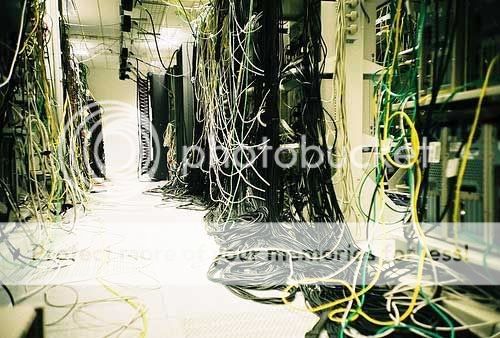Anybody who's ever worked with servers and even a small LAN environment knows (or should know) how messy things can get. Cables, routers, hubs, servers and so on.
Everything crawling where it shouldn't go, and good luck finding that one cable that's preventing John's PC to connect to the rest of the Intranet when John works on the first floor and the servers where you need to check it are on the third floor.
So, for everyone here who works in environments like this: how do you keep it clean? A clean environment means at least some improvement in efficiency, so what are you tricks? What are the absolute do's and don'ts and why?
Or do you enjoy some Spaghetti? 
Hmmm, that's disgusting - but thanks for posting a picture worth-a-thousand-words. 8)
Label both ends of every cable.
The cable should clearly show where each end is going, and you should be as specific as possible.
For example, a label in our data center looks like this:
The same label is put on both ends of the cable so no matter which end you are looking at you know exactly where the end point is.
With this simple process even a mess of spaghetti cables can easily be handled. The biggest problem with spaghetti cables is when you are forced to hand trace a cable to its end point.
However I do recommend cable management to avoid the physical mess :-)
Use velcro tie wraps when running horizontal cable.
It's an obvious one, but use rackmount servers and KVM switches.
Set things up so that your cable runs can be as short as possible. If you can get a space of 1U left between each patch panel in the rack, that's a great place to put switches and it means that you can use quarter meter lengths with no trailing whatsoever, and no need for cable management either (you don't need to manage what isn't there).
Separate things out into different racks if possible. If not, at least arrange them so that, for example, all switches for the first floor are physically located together.
FULLY DECOMMISSION OLD GEAR! If a switch dies, don't leave it in the rack and put a new one in wherever you have space - haul it out of there.
Label the front AND the back of your machines
Blades help.
Nearly everything you can do has been mentioned already. It all comes down to being methodical and strict. Having to hand trace a cable at 2 am, armed only with a tile lifter and a torch is no fun at all.
One addition is to make sure that every cabinet door can be closed, i.e. no bodge jobs connecting device together that bypass the structured cabling. If one is allowed, then others will follow and ultimately you end up with a mess. Before any changes are made, make sure that you can achieve it with structured cabling. If not, you need to re-plan it properly, free up dead ports etc. If not you'll end up with a 20m cable chucked over the top of a row of cabs that is doing something important.
I primarily work in a startup environment. My current organization is a startup, and a previous business model was consulting startups. The biggest key to organization was outsourcing data center operations to dedicated hosting companies like Rackspace and Servepath, and also using cloud and virtualization technologies such as Amazon EC2 and KVM.
I haven't had to trace a cable in almost a year, and finding systems is a matter of looking at the master server that tracks all the nodes that check in for their configuration.
It's much nicer than a previous position where our servers were at a hosting center, but we had to physically manage everything (which resulting in cable messes, despite best efforts and proper labelling).